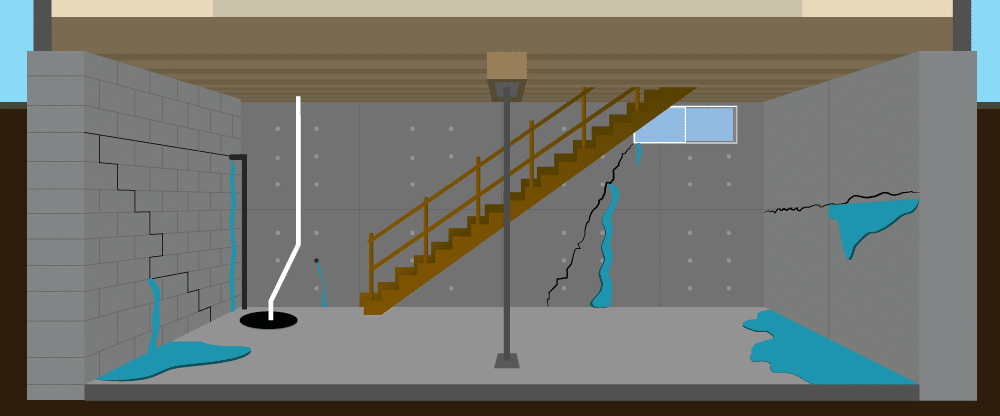Identifying Basement Waterproofing Issues
Our team at Perma Jack of St Louis knows that identifying the causes of basement waterproofing issues can be a challenge. That’s why we have put together the list of problem areas in your basement that you can identify yourself. Take a look at the image below to learn more about areas in your basement that could be letting water into your basement.
Our team at Perma Jack of St Louis knows that identifying the causes of basement waterproofing issues can be a challenge. That’s why we have put together the list of problem areas in your basement that you can identify yourself. Take a look at the items below to learn more about areas in your basement that could be letting water into your basement.

Window Well Leaks
Regularly check window wells in your basement for cracks and leaks.
Cove Joint Seepage
The cove joint is where your foundation walls and floor meet. During heavy storms it can cause water to enter your basement.
Masonry Walls
Cinder block and stone walls are held together with mortar. This mortar can break down causing waterproofing issues.
Wall and Floor Cracks
Wall and floor cracks are two of the leading causes of basement waterproofing issues. They provide a path for water to enter your basement.
Tie Rod Leaks
Tie rods are small steel rods that are used to hold together the forms of a poured foundation during construction. They can cause water to enter your basement.
Pipe Penetrations
Like tie rods any pipe or object which penetrates the foundation walls below-grade can be cause for concern.
1. Window Well Leaks
Below-grade windows form a pocket where water can sit against your basement walls. Over time standing water will break down the seals around the window causing water to enter your basement. This is an easily resolvable waterproofing issue, but may be cause for more substantial repairs.
2. Cove Joint Seepage
The cove joint is where your foundation walls meet your foundation floor. This area is one of the most common places for basement waterproofing issues to occur on St. Louis homes or businesses. Strong storms cause ground water levels to rise which can cause leaks through your cove joint.
3. Masonry Walls
Walls made of cinder blocks or stone have joints that are made from mortar. Over time this mortar can erode, causing water to leak inside and can cause further damage to your walls, floors, and personal items.
4. Wall and Floor Cracks
Wall and floor cracks occur on foundations across the St. Louis area. Water can seep through these cracks during weather events and cause damage to your basement or stored belongings. Be sure to check any floor or wall cracks for leaks during heavy rain as they may be hard to identify when it is not raining.
5. Tie Rod Leaks
Tie rods are small steel rods that are used to hold together the forms of a poured foundation during construction. They are removed where possible and any holes left behind are filled with hydraulic cement. These patches can be seen easily on the inside walls of the basement and are usually in a vertical line with one another. Over time the hydraulic cement could break down causing water intrusions in your basement.
6. Pipe Penetrations
Like tie rods, any pipe or object which penetrates the foundation walls below-grade can be cause for concern. These penetrations often lead to basement waterproofing issues, as water can erode the seals.
Contact our team for Professional Basement Waterproofing in St. Louis
If you have noticed water entering your basement from any of these areas contact our experts today. We offer free inspections and estimates for basement waterproofing across the St. Louis area. You can reach our team by calling 636-225-2553 or by filling out the contact form below.


